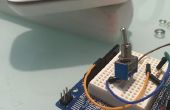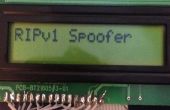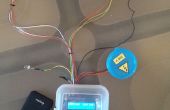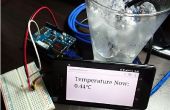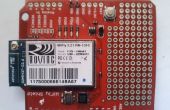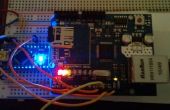Stap 5: Client

Websites hebben een heleboel tekst zowel zichtbare als verborgen, waardoor programmering op de clientzijde erg lastig. Lezen van informatie vanaf websites meestal gaat ontleden alot van tekenreeksen. Dit is gek, maar de moeite waard, als dat is wat u wilt doen.
Ik was van plan om te schrijven wat code om Twitter berichten te lezen, maar een dergelijke code bestaat al als voorbeeld binnen de Arduino-programmeur. In plaats daarvan, mij gewijzigde gewoon iets om te schakelen op een LED als een speciale bericht is gelezen.
Om dit werk steek de positieve stekker een LED aan pin D2, en de negatieve lood in serie met een weerstand van 220 ohm op grond.
Vergeet niet uw eigen IP-adres invoeren in de onderstaande code, anders zal het niet werken.
Hier is de code:
/* Twitter Client with Strings This sketch connects to Twitter using an Ethernet shield. It parses the XML returned, and looks for <text>this is a tweet</text> You can use the Arduino Ethernet shield, or the Adafruit Ethernet shield, either one will work, as long as it's got a Wiznet Ethernet module on board. This example uses the DHCP routines in the Ethernet library which is part of the Arduino core from version 1.0 beta 1 This example uses the String library, which is part of the Arduino core from version 0019. Circuit: * Ethernet shield attached to pins 10, 11, 12, 13 created 21 May 2011 by Tom Igoe This code is in the public domain. */ #include <SPI.h> #include <Ethernet.h> // Enter a MAC address and IP address for your controller below. // The IP address will be dependent on your local network: byte mac[] = { 0x00, 0xAA, 0xBB, 0xCC, 0xDE, 0x01 }; IPAddress ip(191,11,1,1); //<<< ENTER YOUR IP ADDRESS HERE!!! // initialize the library instance: EthernetClient client; const int requestInterval = 60000; // delay between requests char serverName[] = "api.twitter.com"; // twitter URL boolean requested; // whether you've made a request since connecting long lastAttemptTime = 0; // last time you connected to the server, in milliseconds String currentLine = ""; // string to hold the text from server String tweet = ""; // string to hold the tweet boolean readingTweet = false; // if you're currently reading the tweet void setup() { pinMode(2, OUTPUT); // reserve space for the strings: currentLine.reserve(256); tweet.reserve(150); // initialize serial: Serial.begin(9600); // attempt a DHCP connection: if (!Ethernet.begin(mac)) { // if DHCP fails, start with a hard-coded address: Ethernet.begin(mac, ip); } // connect to Twitter: connectToServer(); } void loop() { if (client.connected()) { if (client.available()) { // read incoming bytes: char inChar = client.read(); // add incoming byte to end of line: currentLine += inChar; // if you get a newline, clear the line: if (inChar == '\n') { currentLine = ""; } // if the current line ends with <text>, it will // be followed by the tweet: if ( currentLine.endsWith("<text>")) { // tweet is beginning. Clear the tweet string: readingTweet = true; tweet = ""; } // if you're currently reading the bytes of a tweet, // add them to the tweet String: if (readingTweet) { if (inChar != '<') { tweet += inChar; } else { // if you got a "<" character, // you've reached the end of the tweet: readingTweet = false; Serial.println(tweet); if(tweet == ">Hello Cruel World"){ digitalWrite(2, HIGH); Serial.println("LED ON!"); } if(tweet != ">Hello Cruel World"){ digitalWrite(2, LOW); Serial.println("LED OFF!"); } // close the connection to the server: client.stop(); } } } } else if (millis() - lastAttemptTime > requestInterval) { // if you're not connected, and two minutes have passed since // your last connection, then attempt to connect again: connectToServer(); } } void connectToServer() { // attempt to connect, and wait a millisecond: Serial.println("connecting to server..."); if (client.connect(serverName, 80)) { Serial.println("making HTTP request..."); // make HTTP GET request to twitter: client.println("GET /1/statuses/user_timeline.xml?screen_name=RandyMcTester&count=1 HTTP/1.1"); client.println("HOST: api.twitter.com"); client.println(); } // note the time of this connect attempt: lastAttemptTime = millis(); } U gaat vermoedelijk wilt lezen dat iets anders dan de recente post op de RandyMcTester Twitter feed.
Om te lezen van andere Twitter-feeds, wijzigt u het volgende stuk tekst:
client.println ("GET /1/statuses/user_timeline.xml?screen_name=[nieuwe TWITTER naam hier]& tellen = 1 HTTP/1.1");

